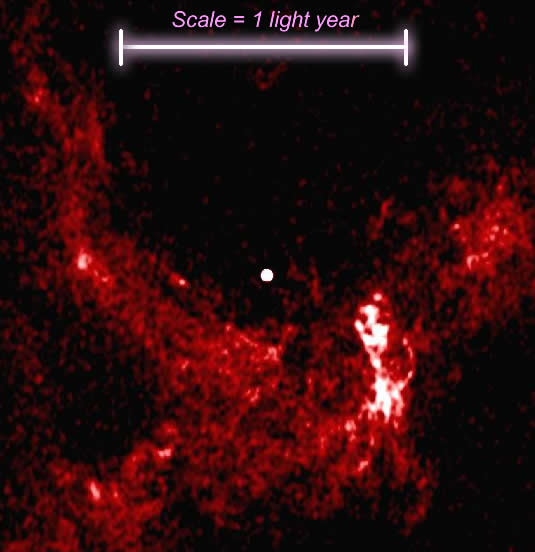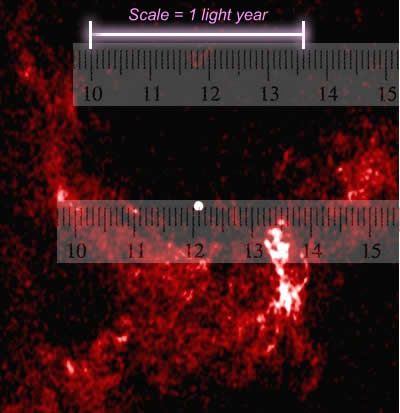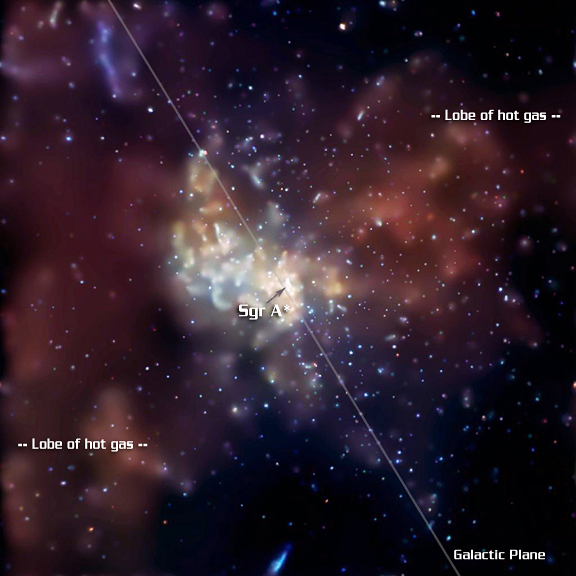The Nucleus
335-336
| On warm summer evenings, look low in the southern Canadian sky in the direction of the constellation Sagittarius. If you know your constellations, look slightly to the right of the "teapot". You are now looking in the direction of the nucleus. Enjoy the view - you won't have exactly this view for another 240 million years! Figure 12.25 shows the galactic centre (marked by the circular icon). This is the point around which the Sun and all else in the galaxy revolves. While not particularly impressive to the un-aided eye and in the visible wavelength region, observations in other parts of the spectrum reveal a violent and turbulent centre to our galaxy. |  |
| Figure 12.25 Location of the galactic centre in the constellation Sagittarius. |
The Nucleus - as Seen in the Radio Region
Figure 12.26 shows the nucleus of our galaxy in the radio part of the spectrum. The image was taken with the Very Long Array (see Chapter 5.4). The bright dot in the center of the image corresponds to the object Sagittarius A and marks the centre of our galaxy. The scale of the image reveals that the centre of our galaxy is both very bright and very compact. This is telling us something very significant about the central region of our own galaxy and most galaxies.
 |
| Figure 12.26 The central region of the Milky Way as seen in the radio region. (Image courtesy NRAO/AUI/NSF, Jun-Hui Zhao, W.M. Goss) |
Example 12.12 Use Figure 12.26 to estimate the size of Sagittarius A.
 |
Solution: The image on the left provides a ruler with which to measure size of Sagittarius A. The top scale of 1 light year corresponds to 3.6 units on the ruler. The bottom ruler indicates that Sagittarius A is 0.2 ruler-units across. This means that Sagittarius A is no bigger than 0.2/3.6 light years across or 0.056 light years across. Recent radio observations with the VLBA indicate that Sagittarius A is considerably smaller yet - less than 1 AU across! This poses an interesting problem - how could an object so small produce the enormous amount of energy that is emitted by Sagittarius A? |
The Nucleus - as Seen in the X-Ray Region and Evidence for a Supermassive Black Hole!
Figure 12.27 is an X-ray image of Sagittarius A taken in the X-ray region with the Chandra space telescope. In this image Sagittarius A is an intense x-ray source surrounded by many other x-ray sources.
 |
Observations reveal that not only does the x-ray emission from this area vary rapidly but there are two huge lobes of very hot gas (temperature greater than 20 million K) on either side of Sagittarius A. All of this points to one thing - a supermassive black hole! The lobes of gas suggest that an enormous explosion or series of explosions propelled this mass outward sometime in the last one thousand to ten thousand years. The rapid variation in x-ray emission from Sagittarius A suggests matter falling into the black hole itself. Current best estimates are that the mass of the central black hole is greater than 3 million times the mass of the Sun. |
| Figure 12.27 Chandra x-ray image of the centre of the Milky Way. |
Example 12.13 Use the rule of thumb (first given in Chapter 11.2) that the radius of a black hole is given as ![]() to estimate the size of the black hole at the centre of the galaxy. Express this in AU's.
to estimate the size of the black hole at the centre of the galaxy. Express this in AU's.
Solution: The rule of thumb suggest that the radius would be![]() which is 0.05 AU.
which is 0.05 AU.
Practice
- Why is the discovery of rapidly varying x-ray emission from Sagittarius A consistent with idea that there is a supermassive black hole at the center of the galaxy?
- If you use the result from Example 12.13 what time-scale would you expect for x-ray emission from Sagittarius A if it is due to a black hole? (Hint: refer to the discussion on how size relates to time of variation that appeared in Chapter 11.1).

To gain an understanding of the nucleus of the Milky Way
Chp 15.4